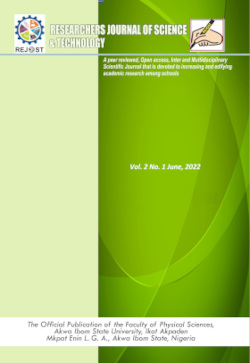Analysis of the local wave vector orientation of plasma waves in the Earth’s Magnetosheath observed by spacecraft in the tetrahedral formation
Keywords:
Magnetosheath, Plasma Waves, Instantaneous Frequency, local wave vector, solar windAbstract
Spacecraft architecture that places the spacecraft in a tetrahedral arrangement rather than in the same plane has been taken into consideration in this analysis. The combination of the empirical mode technique and the simple Hilbert transform have been used on the real-valued signal observed aimed at analyzing the local wave vector orientation of plasma waves in the Earth’s Magnetosheath observed by spacecraft in the tetrahedral formation. The real-valued signal is decomposed into intrinsic mode functions (imf). The tetrahedral geometry of the four Cluster satellite on February 18, 2002, observed at 5: 27: 30 UT, yielded average values of tetrahedron elongation E = 0.070 and planarity P = 0.040 for a scale of 20.000km: 1.000cm. Since the values of E and P for a regular tetrahedron are close to zero, these values are small enough to ensure good results of the 3-D measurement. This produced results in three dimensions along the separation of each satellite pair. The result reveals at some points, a non-dispersive wave. The projections of the wave vector that make angles with the spacecraft separation line enabled the determination of wave orientation with respect to the sun using the solar wind coordinate system. In addition, these angles specify the wave vector's direction. The average minimum and maximum spacecraft separation, according to the results, were 88 and 108 km, respectively. The average value of the plasma bulk velocity during the chosen period is [−175,52, 112] kms−1 in x, y and z directions respectively. The local wave vector projection has been plotted along the spacecraft separation. As a reference satellite, we used Cluster satellite C3. This made it possible to pair, and Sat13, Sat23, and Sat43 were used. The wave's wavelength is between 1030.2 and 1366.1 kilometers. Between the separation line of the Sat13 pair and the projection of each wave vector component, there is an angle that ranges from 87 to 91 degrees. With the use of tetrahedral formation of spacecraft to analyze the local wave vector orientation of plasma waves in the Earth’s Magnetosheath, we believe the wave to be spiral-shaped wave.
References
Balikhin, M. A., Dudok de Wit, T., Alleyne, H. St. C. K., Krasnosel´skikh, V., Mier-Jedrzejeowicz, W. A. C. and Baunmjohann W. (1997a). Experimental determination of the dispersion of waves observed upstream of quasiperpendicular shock. Geophysical Research Letter, 24, NO. 7:787–790.
Balikhin, M. A., Woolliscroft, L. J. C., Alleyne, H. St. C., Dunlop, M., and Gedalin, M. A. (1997b). Determination of the dispersion of low-frequency waves downstream of quasi-perpendicular shock. Ann. Geophysicae, 15:143–151.
Balogh, A., Dunlop, M. W., Cowley, S. W. H., Southwood, D. J., Thomlinson, J. G., Glassmeier, K. H., Musmann, G., Luhr, H., Buchert, S., Acun´a, M. H., Fairfield, D. H., Slavin, J. A., Riedler, W., Schwingenschuh, K. and Kivelson, M. G. (1997). The cluster magnetic field investigation. Space Sci. Rev., 79:65 – 92.
Balogh, A., Schwartz, S. J., Bale, S. D., Balikhin, M. A., Burgess, D., Horbury, T. S. (2005). Cluster at the bow shock: Introduction. Space Science Reviews, 118(1–4), 155–160. https://doi.org/10.1007/s11214-005-3826-1.
Beall, J. M., Kim, Y. C. and Powers, E. J. (1982). Estimation of wavenumber and frequency spectra using fixed probe pairs. J. Appl. Physics, 53:3933–3940.
Boashash, B. (1992). Estimating and interpreting the instantaneous frequency of a signal- part 1: Fundamentals. Proc. IEEE, 80, No. 4:520–538.
Carozzi, T. D., Buckley, A. M. and Gough, M. P. (2004). Instantaneous wave vector estimation from multi-spacecraft measurements using few spatial points. Annales Geophysicae, 22:2633–2641.
Nathaniel, E.U., George, N.J. and Etuk, S.E. (2013). Determination of Instantaneous Frequencies of Low Plasma Waves in the Magnetosheath using Empirical Mode Decomposition (EMD) and Hilbert Transform (HT). Atmospheric and Climate Sciences, 3, 576-580.
Nathaniel, E.U., George, N.J., Ibanga, J.I and Ekanem, A.M. (2016). Efficacy of Hilbert-Huang Transform (HHT) in the analysis of instantaneous low frequency waves of Magnetosheath. International Journal of Geosciences, 7, 11-19.
Flandrin, P., Rilling, G. and Goncalves, P (2004.). Empirical mode decomposition as a filter bank. IEEE Signal Process. Lett., 11, no. 2:112–114.
Gabor, D. (1946). Theory of communication. Jour. IEE, 93, Part III, No. 26:429–457.
Glassmeier, K. H., Motschmann, U., Dunlop, M., Balogh, A., Acun´a, M. H., Carr, C., Musmann, G., Fornacon, K.H., Schweda, K., Vogt, J., Georgescu, E. and Buchert S. (2001). Cluster as a wave telescope- first results from the fluxgate magnetometer. Ann. Geophysicae, 19:1439–1447.
Helong, L., Xiaoyan D. and Hongliang D. (2007). Structural damage detection using the combination method of EMD and Wavelet analysis. Mechanical Systems and Signal Processing, 21:298–306.
Huang, N. E., Shen, Z., Long, S. R., Wu, M. C., Shih, H. H., Zheng, Q., Yen, N., Tung, C. C. and Liu, H. H. (1998). The empirical mode decomposition and the Hilbert spectrum for nonlinear and non-stationary time series analysis. Proc. R. Soc. Lond. A, 454:903–995.
Huang, N. E., Wu, M., Qu, W., Long, S. R. and Shen S. S. P. (2003). Applications of Hilbert-Huang transform to non-stationary financial time series analysis. Appl. Stochastic Models Bus. Ind., 19:245–268.
Huang, N. E. and Shen, S. S. (2005). Hilbert - Huang Transform and its applications. World Scientific Publishing Co. Pte Ltd., Singapore.
Nathaniel, E U., Beloff, N. and George, N.J. (2013). Instantaneous frequency and wave mode identification in a magnetosheath using few spatial points. Chin. Phys. B, Vol. 22, No. 8
Paschmann, G., Haerendel, G., Sckopke, N., Mobius, E., Luhr, H. and Carlson C. W. (1988). Three-dimensional plasma structure with anomalous flow directions near the earth’s bow shock. J. Geophysical Research Letter, 93:11279–11294.
Pinco`n, J. L., and Lefeuvre, F. (1991). Local characterisation of homogeneous turbulence in a space plasma from simultaneous measurements of field components at several points in space. J. Geophys. Res. lett., 96:1789.
Rilling, G. and Flandrin, P. (2006). On the influence of sampling on the empirical mode decomposition. IEEE, page 4.
Robert, P., Roux, A., Harvey, C. C., Dunlop, M. W., Daly, P. W. and Glassmeier, K. H. (1998). Analysis methods for multi-spacecraft data (tetrahedron geometric factors). Int. Space Sci. Inst., Bern, Switzerland, pages 323–348.
Svenningsson, I., Yordanova, E., Cozzani, G., Khotyaintsev, Yu. V., & André, M. (2022). Kinetic generation of whistler waves in the turbulent magnetosheath. Geophysical Research Letters, 49, e2022GL099065. https://doi. org/10.1029/2022GL099065.
Sonnerup, B.U.O. and Cahill, L. J. (1967). Magnetopause structure and attitude from explorer 12 observations. J. Geophys. Res. lett., 72, No. 1:171–183.
Walker, S. N., Sahraoui, F., Balikhin, M. A., Belmont, G., Pincon, J. L., Rezeau, L., Alleyne, H., Cornilleau-Wehrlin, N. and Andr´e, M. (2004). A comparison of wave mode identification techniques. Anales Geophysicae, 22:3021–3032.
CDA - Http://cdaweb.gsfc.nasa.gov/cgi-bin/eval-2.cgi.

Downloads
Published
How to Cite
Issue
Section
License
Copyright (c) 2024 Researchers Journal of Science and Technology

This work is licensed under a Creative Commons Attribution-NonCommercial-NoDerivatives 4.0 International License.




